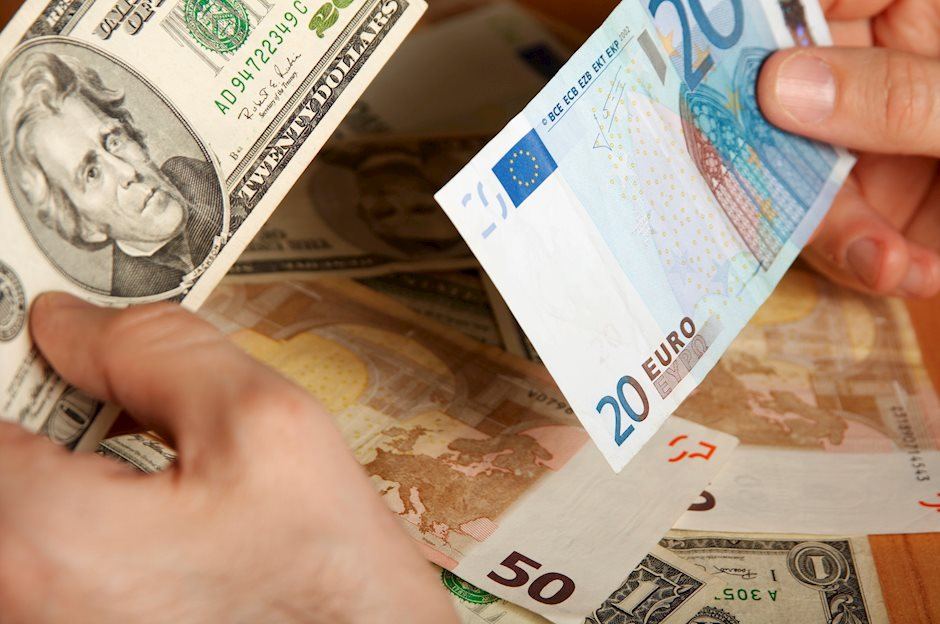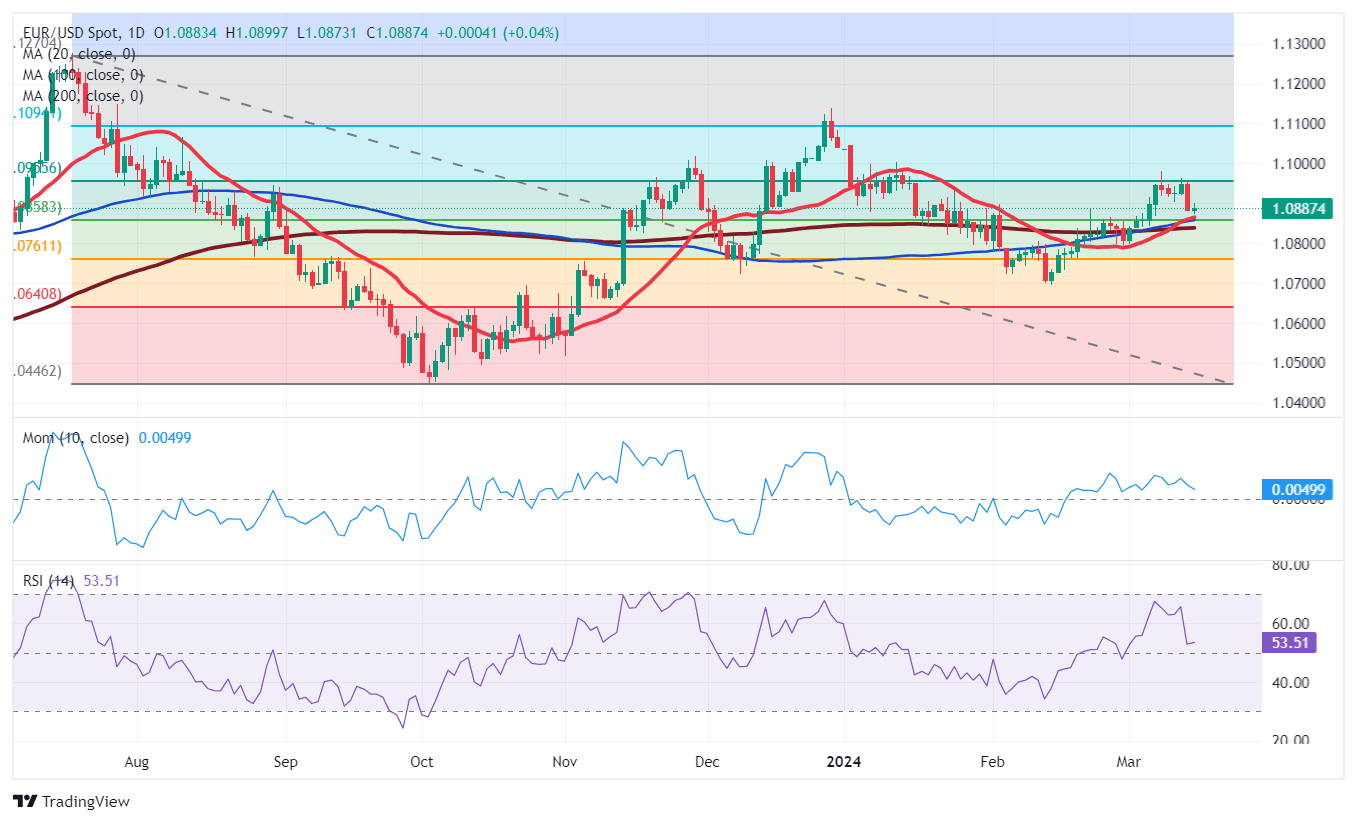EUR/USD Weekly Forecast: Federal Reserve’s monetary policy decision takes the spotlight once again
- The Federal Reserve will announce its decision on monetary policy next week.
- Investors are reducing bets on rate cuts for 2024 as US data supports the Fed’s higher-for-longer case.
- EUR/USD in bearish corrective mode, bulls have not given up and could push the pair beyond 1.1000.

EUR/USD buyers took a break last week, leaving the weakened US Dollar some room to marginally advance. The EUR/USD pair was down from its Monday opening at 1.0938 and settled at around 1.0890.
United States data helps the US Dollar
The Greenback started the week on the back foot despite the tepid market mood but got boosted on Thursday following the release of mixed United States (US) data. On the one hand, the Producer Price Index (PPI) for final demand rose 0.6% in February, higher than the 0.3% added in January. The annual figure printed at 1.6%, higher than the previous 1.0%, while both figures surpassed expectations. The news came after the country reported a higher-than-anticipated Consumer Price Index (CPI), although slightly lower than the one reported in January.
Also on Thursday, the US reported initial claims for state unemployment benefits fell to a seasonally adjusted 209,000 for the week ended March 8, better than the 219K forecast, a sign the labor market remains tight. Finally, consume remains restricted, as Retail Sales increased a modest 0.6% MoM in February.
Across the pond, the European economy continues to struggle to show progress. Industrial Production in the Eurozone plunged 6.7% YoY in January, while Germany confirmed the Harmonized Index of Consumer Prices (HICP) rate at 2.7% YoY in February.
European Central Bank (ECB) officials have been quite busy in the last few days but failed to impress. ECB policymakers offered an optimistic but cautious stance, suggesting the central bank may start loosening monetary policy by June. It is clear that policymakers aim to reduce the impact of such a decision on financial markets, anticipating the movement way in advance so speculative interest digests it before it happens.
Federal Reserve announcement coming up next
And, of course, the ECB is not alone in such a path. The Federal Reserve (Fed) aims the same. Speaking of which, the Fed is set to announce its decision on monetary policy next Wednesday, and is widely anticipated to keep rates on hold. The central bank will also present the Summary of Economic Projections (SEP), or dot-plot, which offers fresh views on inflation and growth expectations from policymakers, alongside potential rate changes for this year and the next ones. The document, released quarterly, previously indicated that officials were willing to deliver three rate cuts through 2024.
The Fed has kept rates steady since lifting the main benchmark to 5.25% - 5.50% in the July 2023 meeting, the highest level in more than two decades. Policymakers aimed to tame skyrocketing inflation, which peaked at 9.1% YoY in June 2022, and one could say they approached success as the Consumer Price Index (CPI) posted an annual increase of 3.2% in February. It is worth reminding the central banks’ goal is to keep inflation around 2%, forcing policymakers to maintain a cautious stance over abandoning record rates.
Finally, it's important to mention that the latest US macroeconomic data, suggesting a still-tight labor market coupled with a slow pace of easing inflation, has increased bets of fewer rate cuts. Market players are considering a possible revision in the dot plot, trimming the 75 basis points (bps) cuts expected to 50 bps.
US rate futures have also pared back the chances of a rate cut at the June meeting to roughly 54%, according to the CME FedWatch Tool, from over 57% a week ago.

Generally speaking, if the central bank opts to loosen monetary policy, the US Dollar will weaken. On the other hand, if the central bank actually reduces the odds of rate cuts, the Greenback may extend its modest weekly recovery in the Fed’s aftermath. Conversely, the USD may fall if policymakers remain optimistic and three rate cuts are in the docket for 2024.
Next week, the Eurozone will publish the final estimate of the February Harmonized Index of Consumer Prices (HICP), expected to be confirmed at 3.1% YoY, and the preliminary estimate of March Consumer Confidence. Also, Germany will release the March ZEW Survey on Economic Sentiment, the February Producer Price Index (PPI) and the March IFO survey on business conditions and expectations.
Finally, the Hamburg Commercial Bank (HCOB) and S&P Global will release the preliminary estimates of the March Producer Manager Indexes (PMIs) for the EU and the US by the end of the week.

EUR/USD technical outlook
For a second consecutive week, the EUR/USD pair met sellers around the 61.8% Fibonacci retracement of the 1.1139-1.0694 daily decline at 1.0971, still a critical resistance level. On the other hand, the pair held above the 38.2% retracement of the same slump at 1.0865, pretty much suggesting the pair may well resume its advance.
Technical readings in the weekly chart limit the scope for a steeper slide. Not only does EUR/USD hold above a bullish 20 Simple Moving Average (SMA) that converges with the mentioned Fibonacci support, but the Momentum indicator turned north within positive levels. At the same time, the Relative Strength Index (RSI) indicator hovers directionless within positive levels, currently around 53. Finally, the 200 SMA converges with the top of the range, standing flat at around 1.1140 and reinforcing the relevance of the level.
Technical readings in the daily chart maintain the risk skewed to the upside despite the latest slide. EUR/USD develops above all its moving averages, with the 20 Simple Moving Average (SMA) heading north above the also bullish longer ones, although all of them remain confined to a tight range. Technical indicators have retreated towards their midlines, erasing the overbought conditions reached last week. The Momentum indicator maintains its downward slope, yet the RSI indicator has turned flat at around 54, suggesting easing selling interest. The daily candle reaffirms so, as per the pair trading around its opening.
Additional support below the aforementioned 1.0865 level could be found at around 1.0820, while the 1.0794 low comes next. Once below the latter, the case for a steeper slide towards 1.0680 will be on the table.
Resistance beyond the 1.0970 area comes at 1.1010, followed by an interim area around 1.1060 ahead of the top of the range at 1.1140.

Fed FAQs
Monetary policy in the US is shaped by the Federal Reserve (Fed). The Fed has two mandates: to achieve price stability and foster full employment. Its primary tool to achieve these goals is by adjusting interest rates. When prices are rising too quickly and inflation is above the Fed’s 2% target, it raises interest rates, increasing borrowing costs throughout the economy. This results in a stronger US Dollar (USD) as it makes the US a more attractive place for international investors to park their money. When inflation falls below 2% or the Unemployment Rate is too high, the Fed may lower interest rates to encourage borrowing, which weighs on the Greenback.
The Federal Reserve (Fed) holds eight policy meetings a year, where the Federal Open Market Committee (FOMC) assesses economic conditions and makes monetary policy decisions. The FOMC is attended by twelve Fed officials – the seven members of the Board of Governors, the president of the Federal Reserve Bank of New York, and four of the remaining eleven regional Reserve Bank presidents, who serve one-year terms on a rotating basis.
In extreme situations, the Federal Reserve may resort to a policy named Quantitative Easing (QE). QE is the process by which the Fed substantially increases the flow of credit in a stuck financial system. It is a non-standard policy measure used during crises or when inflation is extremely low. It was the Fed’s weapon of choice during the Great Financial Crisis in 2008. It involves the Fed printing more Dollars and using them to buy high grade bonds from financial institutions. QE usually weakens the US Dollar.
Quantitative tightening (QT) is the reverse process of QE, whereby the Federal Reserve stops buying bonds from financial institutions and does not reinvest the principal from the bonds it holds maturing, to purchase new bonds. It is usually positive for the value of the US Dollar.
Premium
You have reached your limit of 3 free articles for this month.
Start your subscription and get access to all our original articles.
Author

Valeria Bednarik
FXStreet
Valeria Bednarik was born and lives in Buenos Aires, Argentina. Her passion for math and numbers pushed her into studying economics in her younger years.

















